Asia's LCCs increasingly see room to serve both Macau and Hong Kong in the booming Pearl River Delta
AirAsia Philippines' two new international routes launched on 19-Jul-2012 were notable in that the services were to Hong Kong and Macau, 20nm apart and previously considered too similar to warrant service to both. But regional Asian carriers, and LCCs especially, are increasingly finding they can support service to both cities. Also on 19-Jul-2012, Asiana LCC subsidiary Air Busan opened a route to Macau, complementing its Hong Kong service.
While Hong Kong and Macau may be geographically close, the division by the South China Sea dictates different catchment areas, with Hong Kong also serving Shenzhen in mainland China while Macau can serve the mainland's Zhuhai, whose airport is only for domestic flights. The regions are not equals, and only Thai AirAsia has more capacity into Macau than Hong Kong. But as Asia's population and economy continues to grow, the Pearl River Delta's airports will be Asia's equivalent to the London, New York City or Sao Paulo airport networks.
- Eight Asian low-cost carriers serve both Macau and Hong Kong, indicating the increasing demand for service to both cities.
- Hong Kong serves as the preferred port for international carriers, while Macau is heavily focused on leisure travel.
- Chinese carriers also serve Zhuhai, the region's fourth airport, in addition to Hong Kong and Macau.
- LCCs owned by full-service carriers, such as Air Busan and Thai Smile, are being used to serve Macau.
- The Pearl River Delta airports, including Hong Kong, Guangzhou, Shenzhen, and Macau, offer more seats than Sao Paulo but fewer than London.
- With the planned expansion of airports in the region, airlines can support service to multiple Pearl River Delta airports.
Eight Asian low-cost carriers serve both Macau and Hong Kong
The 19-Jul-2012 launches from Air Busan and AirAsia Philippines brought to eight the number of LCCs serving both Macau and Hong Kong. The Jetstar Group is now the only major LCC serving Hong Kong but not Macau (excludes five smaller LCCs which currently only serve Hong Kong). Singapore-based Jetstar Asia dropped service to Macau in Feb-2012.
Five of the LCCs serving both Hong Kong and Macau are based in Southeast Asia, one in China (Spring Airlines) and two in South Korean (Air Busan and Jin Air). The only regional (but not intercontinental) carrier serving both Hong Kong and Macau is Taiwan's Mandarin Airlines, which follows a full service carrier model.
Included in the LCC grouping are three affiliates of the AirAsia Group: AirAsia Malaysia, AirAsia Philippines and Thai AirAsia. Its final active affiliate, Indonesia AirAsia, primarily operates around Southeast Asia.
Three carriers - AirAsia, Thai AirAsia and Tiger Airways - also serve Shenzhen, 21nm north of Hong Kong and in mainland China.
Regional carriers (excluding China) serving both Hong Kong and Macau, and optionally Shenzhen: 23-Jul-2012 to 29-Jul-2012
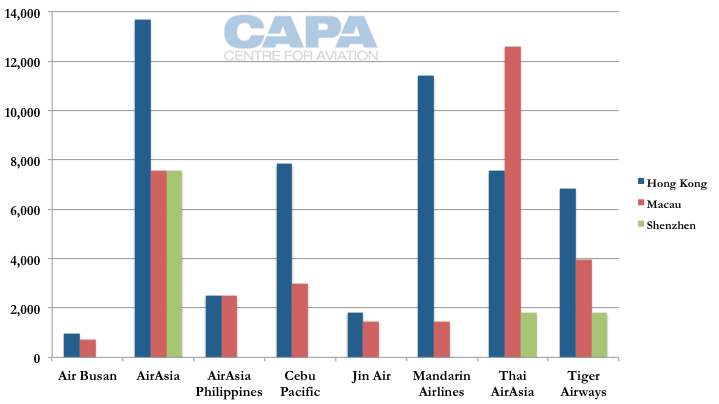
Chinese LCCs also serve Zhuhai, the region's fourth and smallest airport. Most Chinese carriers - both LCC and full service - serve all four airports.
Mainland Chinese carriers serving both Hong Kong and Macau, and optionally Shenzhen and/or Zhuahi: 23-Jul-2012 to 29-Jul-2012

Hong Kong preferred port for international carriers, and Shenzhen for Chinese carriers
For international carriers, Hong Kong is the preferred port in the Pearl River Delta, with only Thai AirAsia deploying more capacity to Macau while AirAsia Philippines for now has equal capacity deployment to Hong Kong and Macau. As the carrier ramps up international expansion, Hong Kong is expected to see a greater share of services.
Air Busan and Jin Air, the low-cost arms of respective parents Asiana and Korean Air, have too little capacity deployment for meaningful comparison, but as a general rule their priorities take second place to the parent carrier and their growth is stunted. Of the three non-Chinese LCCs also serving Shenzhen, Thai AirAsia and Tiger Airways have a fraction of capacity to Shenzhen, but AirAsia deploys approximately the same amount of capacity to Shenzhen as Macau.
The origin of services to Hong Kong and Macau is often the same but there are exceptions. Thai AirAsia serves Macau from Chiang Mai (one daily flight) and Bangkok (four daily flights) while it serves Hong Kong from Bangkok (two daily flights) and Phuket (one daily flight). AirAsia Malaysia serves Macau only from Kuala Lumpur (three daily flights) while it serves Hong Kong from Kota Kinabalu (10 weekly flights), Kuala Lumpur (three daily flights) and Penang (one daily flight).
The situation is much different amongst Chinese carriers, where there can be little overlap. Air China serves Macau only from Wuhan while it links Hong Kong with Beijing, Chengdu, Chongqing, Dalian and Tianjin (but not Wuhan). Xiamen Airlines links Macau from Fuzhou, Hangzhou and Quanzhou but from Hong Kong only to Quanzhou and Xiamen, making Xiamen Airlines the sole Chinese carrier to have more capacity from Macau than Hong Kong.
Nine regional carriers serve Hong Kong but not Macau
There are nine regional non-Chinese carriers that serve Hong Kong but not Macau: Airphil Express, Bangkok Airways, Far Eastern Air Transport, Jeju Air, Jetstar, Mongolian Airlines, Orient Thai, Peach Aviation, and SEAir. Of these, five follow LCC models - Airphil, Jeju Air, Jetstar, Peach and SEAir.
These carriers, however, collectively account for only about 2% of Hong Kong's total seat capacity. Additionally, Mongolian Airlines (affiliated with the Bodhi Group and not to be confused with MIAT Mongolian Airlines) and Peach Aviation are less than a year old. In comparison, the carriers that serve both Hong Kong and Macau comprise 11% of Hong Kong's capacity.
Thai Smile and Air Macau are the only carriers that serve Macau but not Hong Kong. Thai Smile, which follows a hybrid regional/LCC model, launched services on 07-Jul-2012 and currently only serves one route - Bangkok-Macau.
Macau sees service from LCCs owned by full service carriers
The commencement of services to Macau from Air Busan on 19-Jul-2012 and Thai Smile on 07-Jul-2012 capped a theme of full service carriers using LCC or low-fare affiliates to serve Macau, which is heavily a leisure destination compared to Hong Kong. Thai Smile is a unit of Thai Airways and uses the TG code as well as Thai Airways' Air Operator's Certificate (AOC). "Thai had wanted to come to Macau for a long time," said Thai Airways executive vice president commercial Pandit Chanapai, speaking to CAPA during Thai Smile's launch event in Macau.
See related article: Thai Airways unit Thai Smile seeks to prove itself as a new type of carrier for Asia
Besides Thai Smile, other LCC or low-fare affiliates from full service carriers serving Macau are Air Busan (parent company: Asiana), Jin Air (Korean Air), Mandarin Airlines (China Airlines) and Tiger Airways (Singapore Airlines Group). Notably, SIA Group's leisure-focused premium carrier, SilkAir, no longer serves Macau. Taiwan's EVA serves both Hong Kong and Macau whereas China Airlines (the largest foreign carrier at Hong Kong) deploys its regional subsidiary Mandarin Airlines to Macau.
Pearl River Delta airports offer more seats than New York, but fewer than London
The four major airports comprising the Pearl River Delta offer more seats than Sao Paulo or New York City's three area airports, but less than London's five airports.
Comparison of New York City, London, Pearl River Delta and Sao Paulo airports (seats): 23-Jul-2012 to 29-Jul-2012
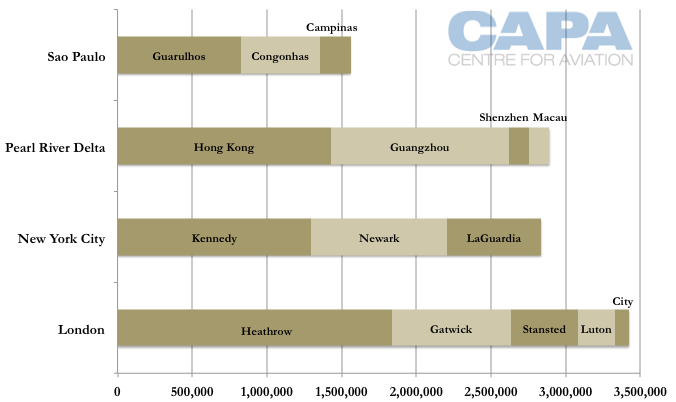
Comparison of New York City, London, Pearl River Delta and Sao Paulo airports (seats): 23-Jul-2012 to 29-Jul-2012
| Ranking | New York City | London | Pearl River Delta | Sao Paulo |
|---|---|---|---|---|
| 1 |
1,297,776 Kennedy |
1,834,166 |
1,426,561 |
825,027 |
| 2 |
909,407 |
797,587 |
1,193,995 |
526,737 |
| 3 |
627,928 |
450,890 |
134,408 |
231,658 |
| 4 | n/a |
246,666 |
135,995 |
n/a |
| 5 | n/a |
95,072 City |
n/a | n/a |
| Total | 2,835,111 | 3,424,381 | 2,890,959 | 1,583,422 |
New York City, however, still has a lead over the Pearl River Delta airports when evaluating available seat kilometres. The Delta, with 6% fewer ASKs than New York City, is projected to overtake the New York City area in terms of ASKs around 2015.
Comparison of New York City, London, Pearl River Delta and Sao Paulo airports (ASKs): 23-Jul-2012 to 29-Jul-2012

Comparison of New York City, London, Pearl River Delta and Sao Paulo airports (ASKs): 23-Jul-2012 to 29-Jul-2012
| Ranking | New York City | London | Pearl River Delta | Sao Paulo |
|---|---|---|---|---|
| 1 | 5,555,633,010
Kennedy |
7,332,688,933 |
4,629,725,909 |
2,340,165,294 |
| 2 | 2,707,333,195 |
1,621,282,292 |
1,984,295,340 |
297,749,163 |
| 3 | 770,290,159 |
529,469,082 |
945,566,577 |
192,471,319 |
| 4 | n/a |
337,504,830 |
183,986,176 |
n/a |
| 5 | n/a |
63,776,528 City |
n/a | n/a |
| Total | 8,263,736,654 | 9,884,721,665 | 7,743,574,002 | 2,830,385,776 |
Including Guangzhou in the Pearl River Delta area, the total area encompassed is significantly larger, and would be more comparable to including Bradley, Islip and Philadelphia in the New York City area. Excluding Guangzhou, the Pearl River Delta would have a more comparable area to New York City but have 60% of New York City's flights. The Pearl River Delta area including Guangzhou could be expected to overtake a greater New York City area before the end of the decade.
London area airports: Jul-2012
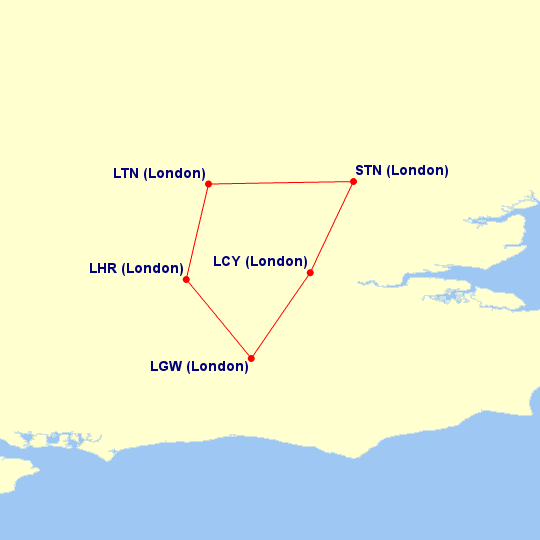
New York City airports: Jul-2012
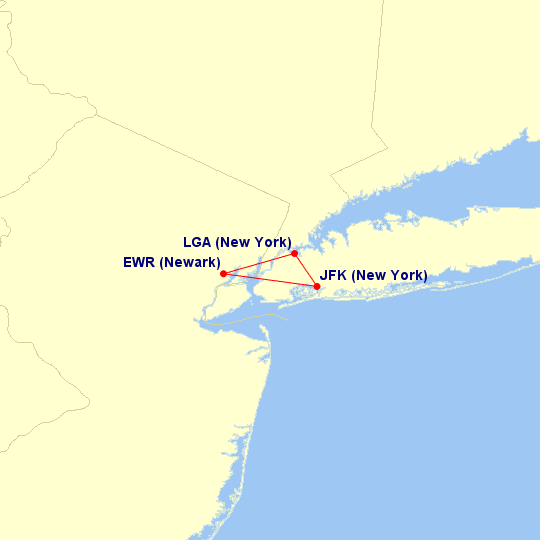
Pearl River Delta airports: Jul-2012
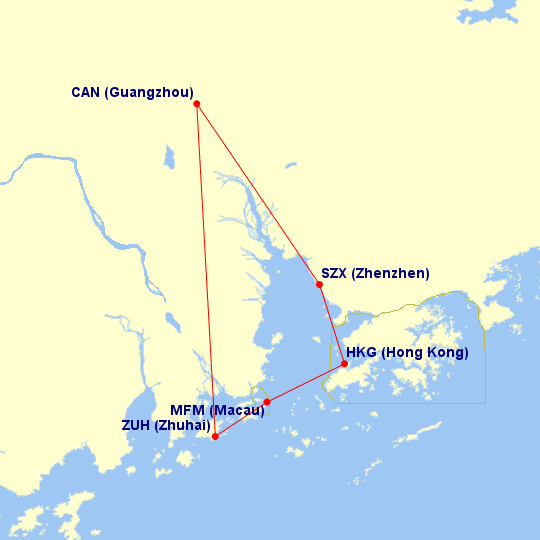
Sao Paulo airports: Jul-2012
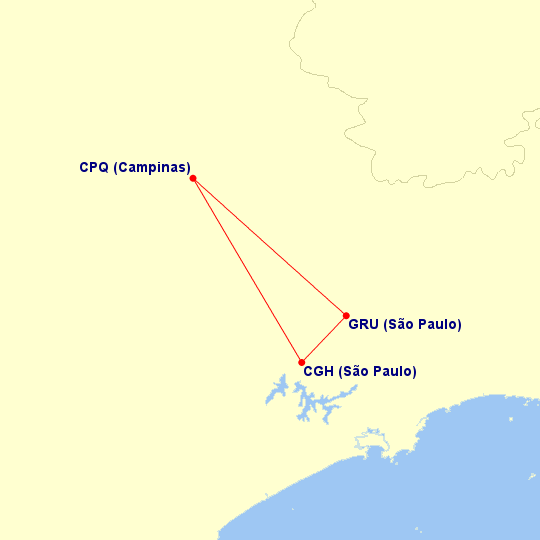
With large growth ahead, airlines can support service to multiple PRD airports
Hong Kong has approved construction of a third runway and is now planning a new terminal while Guangzhou is about to begin construction of its third runway. Guangzhou is already mainland China's third largest (18th globally) and slightly behind Shanghai Pudong. Shenzhen opened a second runway last year, leaving Macau and Zhuhai as the only one runway airports in the region. All this growth potential, including growing interest in Shenzhen and Macau makes this compact region - home to over a million people and some of the highest GDP output from the region - worthy of service from airlines to multiple airports.